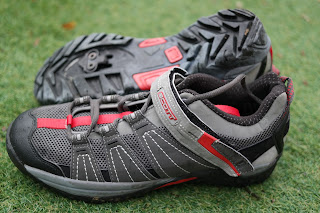So, I’ve reached our
conclusions regarding the Ugoe 2000 headlight https://www.sevendaycyclist.com/ugoe-2000 and
The Oxford Bright Stop rear LED light https://www.sevendaycyclist.com/oxford-bright-stop-rear-led-light
I’ve turned my focus to mile munching with the Schwalbe Marathon Mondial https://www.facebook.com/Sevendaycyclistmagazine/videos/1367504860051913/
which are performing convincingly, both
on and off road. https://www.facebook.com/Sevendaycyclistmagazine/videos/324364064784396/c
No, they’re not a trail tyre,
in the cross country mtb sense. Rather they’re go-anywhere, all-terrain rubber.
Sure, they’re not going to carve through the gloop like an aggressive knobbly,
or glide over asphalt with the same speed as a slick.
However, rolling resistance is
considerably lower than their weight and 26x2.0inch profiles would suggest. Off
road, they’ll take unmade tracks, bridle path and less intense forest trails,
in their stride. The stuff that really turned me on, to mountain biking as a
teenager. Also explains Gravel’s appeal (much the same principle, just tackled
on bikes with more cyclo cross in their DNA).
Lightweight, rugged machines
that could go anywhere and perform with similar finesse. Slower across asphalt
than a road or touring rig but the ability to vanish at speed along a dirt road.
Feeling the ear to ear grin grow and leaving the world behind.
Powerfully enticing now, much
less a bored teen, stifled by school’s rigid conformity. I wasn’t disinterested
in education, just the context and curriculum. Thankfully, there were a few
suitably disruptive students, for teachers to actively “zoo-keep”.
This left me to read the
latest Specialized or Cannondale test, sans introspection, let alone
chastisement. My sincerest thanks go to Jane
Wright (as she was, then) who rose from her seat and burst into the Communards’
“Don’t leave me this way”. Surreal, in the Dennis Potter sense. Perfectly
timed, mid-afternoon, during double French, with Miss Diaper...
Back to 2018…
As things turn wetter,
thoughts turn to waterproof kit and we’ve also been putting some wallet
friendly panniers, https://www.sevendaycyclist.com/oxford mudguards https://www.sevendaycyclist.com/oxford-full-length-mudguard-kit
and tyres https://www.sevendaycyclist.com/vee-tire-co-easy-street-tyre
through their paces. Aimed at commuters,
all three seem to offer a decent amount of bang, for modest buck.
The motor oil challenge
continues and much as I expected. The 5w/40 remains very stoical but is
collecting moderate amounts of gunk, which are being purged on a weekly basis before
it becomes a drivetrain gobbling, grinding paste. Stoicism aside, shifts are very slick and
silent, I latterly dribbled a tiny drop into every link.
There’s no one formula, for
every occasion, in my experience, hence I like to alternate between lubricants,
depending on the season. Self-cleaning wax types are particularly appealing.
Low friction, lower maintenance (save for more frequent reapplication).
Home brewed variants are also
extremely cheap to make (once you’ve got the consistency right). However, some
commentators forget that the time and materials invested in this, have a cost
(not to mention, mess) implication, which pushes their real “start-up” cost
considerably higher (although I fully appreciate this can be recouped quite
quickly over time).
Similarly, if you are unsure of
correct brewing procedure, buying stock products is much cheaper than an
explosion. The sort, resulting in an open plan terrace, and strained
neighbourly relations.
One of the major advantages shared
by motor oil, chainsaw oil and more traditional wet lubes, is the ability to drizzle
on, wipe and scoot off. Perfect during late autumn and winter, where daylight
is at a premium.
Speaking of forest fun, Sharon
booked us a Forest Holidays break, in Nottingham last week. https://www.forestholidays.co.uk/?channel=ppc&gclid=Cj0KCQiAoo7gBRDuARIsANeJKUZ7A2ySyU__cEKkSfGO4ECVjym1pua6fPB-flh5RolooJh1ngRO6IYaAt14EALw_wcB&gclsrc=aw.ds
Despite some poor light, and inclement
conditions, I managed a fair bit of mooching and captured a bit of trail
action, for good measure.
En route up, I dropped my
Shutter Precision PD8 dynohub wheel, with John Moss. Unfortunately, John says
the hub is poorly, rendering spoke tensioning academic. Thankfully, Ison
distribution www.ison-distribution.com
have come to my rescue and will sort, under warrantee…

























































